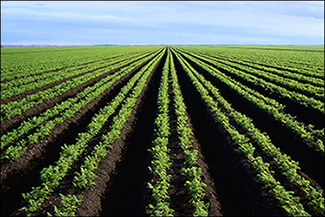
Agricultural Operations
Agriculture ranks among the most dangerous industries. Between 2003 and 2011, 5,816 agricultural workers died from work-related injuries in the US.1,2
- In 2011, 570 agricultural workers died from work-related injuries.1 The fatality rate for agricultural workers was 7 times higher than the fatality rate for all workers in private industry; agricultural workers had a fatality rate of 24.9 deaths per 100,000, while the fatality rate for all workers was 3.5.3
- The leading cause of death for farmworkers between 1992 and 2009 was tractor overturns, accounting for over 90 deaths annually. The most effective way to prevent tractor overturn deaths is the use of Roll-Over Protective Structures; however in 2006 only 59% of tractors used on farms in the US were equipped with these devices.2
- Every day, about 243 agricultural workers suffer a serious lost-work-time injury. Five percent of these injuries result in permanent impairment.2
- In 2011, the injury rate for agricultural workers was over 40 percent higher than the rate for all workers. Crop production agricultural workers' injury rates were 5.5 per 100 workers. Animal production agricultural workers’ injury rates were 6.7 per 100 workers. The rate for all workers was 3.8.4
- Young workers who live and work on farms are also exposed to potentially dangerous farm-related hazards. Farm operators who hire youth to work on their farm should be aware of all applicable child labor laws.
- Approximately one half of farmworkers are Hispanic. OSHA requires that employers conduct all required training of workers in a language and vocabulary workers can understand. OSHA lists Spanish-language outreach resources on the following pages: Hispanic Outreach Module of Compliance Assistance Quick Start, Spanish-Language Compliance Assistance Resources, Spanish-Language Publications, and Podemos Ayudar (We Can Help).
Agricultural operations are covered by several Occupational Safety and Health standards including Agriculture (29 CFR 1928), General Industry (29 CFR 1910), and the General Duty Clause. You can view all of the applicable OSHA standards, preambles to final rules, directives and standard interpretations for agricultural operations, as well as other Federal standards applicable to Agriculture here.
Note: For all Bureau of Labor Statistics (BLS) data in this Safety and Health Topics Page, "agricultural worker" refers to any worker in the Agriculture, Forestry, Fishing and Hunting (GP2AFH) industry. These numbers are the best available representation of workers in the agricultural industry.
How do I find out about employer responsibilities and workers' rights?
Workers have a right to a safe workplace. The law requires employers to provide their employees with safe and healthful workplaces. The OSHA law also prohibits employers from retaliating against employees for exercising their rights under the law (including the right to raise a health and safety concern or report an injury). For more information see www.whistleblowers.gov or Workers' rights under the OSH Act.
OSHA can help answer questions or concerns from employers and workers. To reach your regional or area OSHA office, go to the OSHA Offices by State webpage or call 1-800-321-OSHA (6742).
Small businesses may contact OSHA's free On-site Consultation services funded by OSHA to help determine whether there are hazards at their worksites. To contact free consultation services, go to OSHA's On-site Consultation webpage or call 1-800-321-OSHA (6742) and press number 4.
Workers may file a complaint to have OSHA inspect their workplace if they believe that their employer is not following OSHA standards or that there are serious hazards. Workers can file a complaint with OSHA by calling 1-800-321-OSHA (6742), online via eComplaint Form, or by printing the complaint form and mailing or faxing it to the local OSHA area office. Complaints that are signed by a worker are more likely to result in an inspection.
If you think your job is unsafe or if you have questions, contact OSHA at 1-800-321-OSHA (6742). Your contact will be kept confidential. We can help. For other valuable worker protection information, such as Workers' Rights, Employer Responsibilities, and other services OSHA offers, visit OSHA's Workers' page.
Highlights
- NEW Green Tobacco Sickness*. OSHA-NIOSH Recommended Practices, (2015). Also available in Spanish*.
- Tree Care Work: Falls and Falling Object Hazards (PDF | EPUB** | MOBI**). OSHA Hazard Bulletin (Publication HB-3731), (2014). Also available in Spanish* | EPUB** | MOBI**).
- Safe Use of Tripod Orchard Ladders (PDF*). OSHA Fact Sheet (Publication FS-3728), (2014).
- Protecting Workers from Tripod Orchard Ladder Injuries*. OSHA QuickCard™ (Publication 3705), (2014). Also available in Spanish*.
Farmworkers are at high risk for fatal and nonfatal injuries, work-related lung diseases, noise-induced hearing loss, skin diseases, and certain cancers associated with chemical use and prolonged sun exposure.

1 Bureau of Labor Statistics (BLS), United States Department of Labor. Occupational Injuries and Illnesses and Fatal Injuries Profiles database queried by industry for Agriculture, Forestry, Fishing and Hunting (GP2AFH), Accessed June 2013.
2 Agricultural Safety. Centers for Disease Control and Prevention, National Institute for Occupational Safety and Health (NIOSH) Workplace Safety and Health Topic.
3 Bureau of Labor Statistics, United States Department of Labor. Number and rate of fatal occupational injuries, by industry section, 2011. Available online*.
4 Workplace Injuries and Illnesses - 2011. Department of Labor, Bureau of Labor Statistics (BLS) News Release, October 25, 2012.
*Accessibility Assistance: Contact OSHA's Directorate of Standards and Guidance at (202) 693-1999 for assistance accessing PDF materials.
All other documents, that are not PDF materials or formatted for the web, are available as Microsoft Office® formats and videos and are noted accordingly. If additional assistance is needed with reading, reviewing or accessing these documents or any figures and illustrations, please also contact OSHA's Directorate of Standards and Guidance at (202) 693-1999.
**eBooks - EPUB is the most common format for e-Books. If you use a Sony Reader, a Nook, or an iPad you can download the EPUB file format. If you use a Kindle, you can download the MOBI file format.
Back to Top Translate
Translate